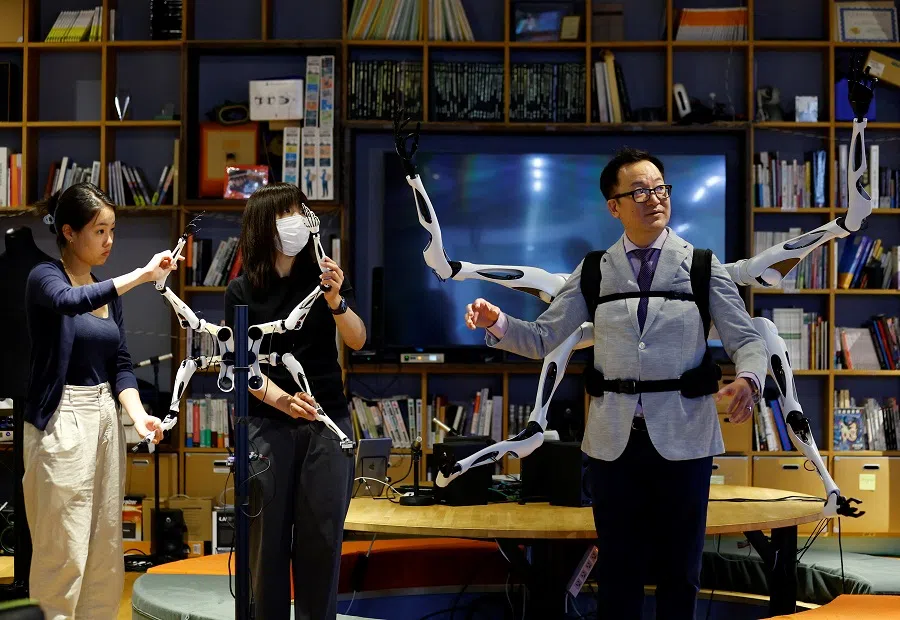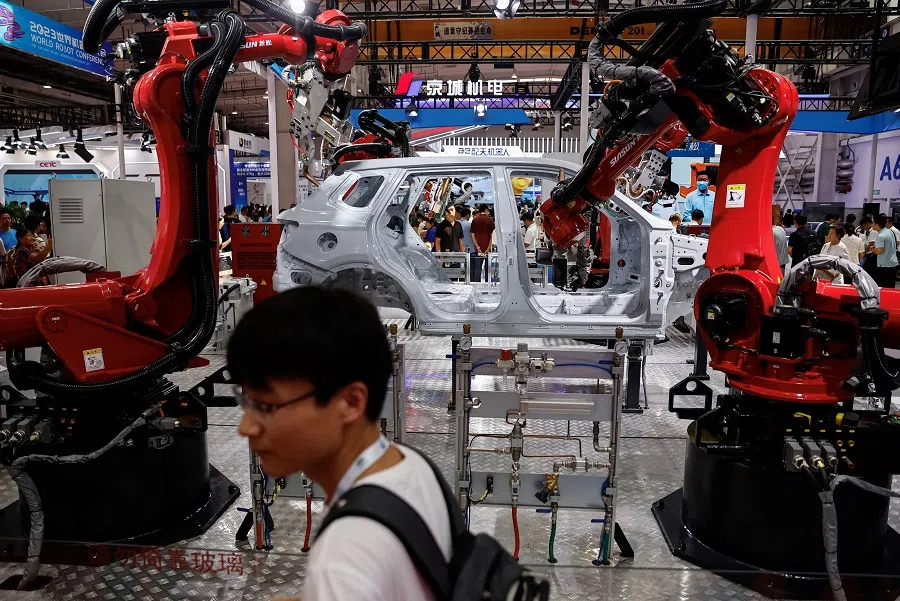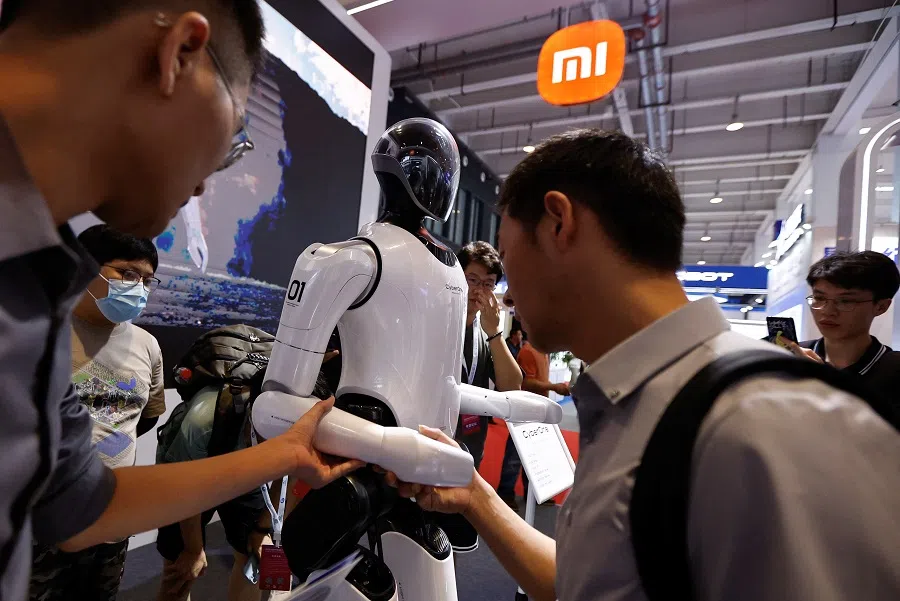China's humanoid robots catching up with US and Japan?
Humanoid robots have become the latest trend in the tech industry, with US and Chinese tech firms trying to beat each other to the punch in releasing their robots. While China is still lagging behind in software, the hardware gap between China and the US and Japan is expected to shrink.

During a visit to Suzhou-based Dreame Technology's exhibition hall, I was greeted by a human-sized robot and a friendly robot dog, while surrounded by a display of the company's flagship vacuum cleaners and robot vacuums.
Known for its robot vacuums, this unicorn launched its second-generation bionic robot dog and general-purpose humanoid robot in March this year. Dreame founder and CEO Yu Hao told Lianhe Zaobao that the company plans to mass produce 1,000 robots within the year to greet customers at its physical stores.
"After observing the Tesla robots, I noticed that our robots were actually better at walking. So we decided to launch it first to attract more resources and talent." - Zen Koh, Fourier Intelligence co-founder
Robots with multiple functions
With the rapid development of artificial intelligence (AI) and motion control technologies, humanoid robots are becoming the latest trend in the technological field. American electric vehicle giant Tesla announced in late July that it would be testing its self-driving robots in the company's factories next year. Several Chinese companies, including Dreame, are already planning to jump ahead of the pack.
Shanghai-based Fourier Intelligence recently launched its humanoid robot GR-1 in early July and plans to begin mass production by the end of the year. Fourier Intelligence co-founder Zen Koh said in an interview that most laboratory robots still walk with bent knees but the GR-1 is able to use its 40 joints to walk upright.

Koh said, "After observing the Tesla robots, I noticed that our robots were actually better at walking. So we decided to launch it first to attract more resources and talent."
Similarly, after watching Tesla's robot video, Dreame CEO Yu also assessed that their robots were more advanced than Tesla's in terms of rotary motors and other actuators, and could be applied in more scenarios. "We're trying to make our robots brew coffee, tidy clothes and make the bed," he said.
The world's first humanoid robot was developed by Japan's Waseda University in the 1970s. But over the years, their robots could only be used in specific areas. With the maturation of AI, tech giants such as Google and Amazon have entered the field, with Tesla taking the lead in the humanoid robot market within a short span of two years due to its strong software and supply chain capabilities.

The popularisation of large language models such as ChatGPT this year has significantly reduced the cost of AI applications and expanded the areas where humanoid robots could be used. Nvidia Corporation co-founder and CEO Jensen Huang said in May that the next wave of AI is embodied AI. Furthermore, management consulting company McKinsey & Company predicts that robotic automation will replace up to 800 million jobs by 2030.
If there's no external interference, China's robots could become world number one in two to three years. - Xie Ming, Associate Professor, School of Mechanical & Aerospace Engineering, Nanyang Technological University
China closing in behind US and Japan
Given the massive potential market, Chinese tech giants such as Baidu and Xiaomi have also entered the humanoid robot market. Tencent-backed UBTECH Robotics Inc. has even filed for IPO in Hong Kong this year in an attempt to become the first humanoid robot stock. UBTECH Robotics' prospectus showed that the company has sold over 500,000 robots as of the end of September 2022.
Associate Professor Xie Ming of Nanyang Technological University (NTU)'s School of Mechanical & Aerospace Engineering said in an interview that China has rapidly improved the standards of its humanoid robots in recent years and is currently behind only the US and Japan. If there's no external interference, China's robots could become world number one in two to three years.

But there is still a significant gap between Chinese robots and those produced by leading international manufacturers in terms of core component technologies. For example, Xie noted that advanced sensors and controllers are dominated by Japan, while chips mainly come from the US and Europe.
If the US joins hands with its allies in imposing more export controls on China, it will take some time for China to rebuild its supply chain, which would greatly delay the development of robots.
Sun Lining, dean of the School of Mechanical and Electric Engineering at Soochow University, said at a forum in April that key basic technologies are bottlenecks to the development of China's robotics industry. At the same time, high-end reduction drives, servomotors, controllers, specialist AI chips and other technical difficulties must still be overcome. He added that industrial chain resilience needs to be strengthened, while the innovation chain and collaborative innovation system must be further enhanced.
According to Zen Koh, the motors, sensors and control systems of Fourier Intelligence's robots are developed in-house, leveraging the company's rich experience in rehabilitation robotics research and development, as well as the Chinese market's massive size and efficiency.
"When I did research and development in Singapore, we made sure to reach 100% in every phase before moving forward. But in China, we can launch a product as long as we reach 80%..." - Zen Koh, Fourier Intelligence co-founder

China's industrial robot installations have long accounted for more than half of the global market share; service robots used in restaurants and the hospitality industry have developed rapidly as well. According to the Chinese Institute of Electronics, China's robotics industry surpassed the 100 billion RMB (US$13.9 billion) mark last year, with industrial, service and special-purpose robots accounting for about 50%, 37% and 13% respectively.
Prior to starting a business in China in 2017, Koh was a researcher at a tertiary institution in Singapore and worked at several multinational corporations. He said, "When I did research and development in Singapore, we made sure to reach 100% in every phase before moving forward. But in China, we can launch a product as long as we reach 80%, and slowly move forward from there. This means that many technologies can be launched quickly in China."
Developing the bigger 'brain'
Associate Professor Zhu Feida of Singapore Management University's School of Computing and Information Systems analysed that China offers a larger market for humanoid robots, with more diverse usage scenarios such as service and healthcare. The greater competition also helps to accelerate the growth of the industry.
Zhu also pointed out that following technological advancements, the core competency of humanoid robots has transformed from athleticism to AI, with the US clearly dominating the field. "Humanoid robots are the ultimate form of AI; the one with the more developed 'brain' will run further in this race," he noted.
NTU's Xie Ming also thinks that while China has a huge advantage in product innovation, it is still lacking in theoretical and technological innovation. He expects the hardware gap between China, the US and Japan to shrink over time, but software will still lag behind significantly. "If China strengthens its investment in software development and talent nurturing as soon as possible, the gap with developed countries is expected to narrow within ten years," he estimated.
Fourier Intelligence set up an overseas business division in 2018. "We can bring our technology overseas through cooperation..."

Compared with smartphones, humanoid robots do not have a huge demand for advanced chips, and the Chinese robotics industry is not significantly affected by the US's chip export controls. But The Wall Street Journal reported that the US Department of Commerce is considering new restrictions on the exports of AI chips to China, which could further cripple the country's AI development.
Koh said frankly that while industry practitioners do not wish to see the intensification of the China-US tech war, it is beyond their control. Thus, Fourier Intelligence set up an overseas business division in 2018. "We can bring our technology overseas through cooperation so that more universities and organisations can use our robots in different scenarios and help us accelerate our technological development," he explained.
However, Dreame CEO Yu Hao thinks that in the absence of mature technology on either side, the US's export controls is not the most significant challenge facing Dreame. "We are facing the unknown together and anyone can fail. We are all exploring alongside one another, testing the limits of our intelligence and our exploration of application scenarios," he said.
This article was first published in Lianhe Zaobao as "中国科企抢跑人形机器人赛道".
Related: Commercial opportunities of the new AI wave still some way away | China's strides in AI: Promising but not without its challenges | Homegrown robots are marching into Chinese factories | ChatGPT will permeate all facets of our work and life | How geopolitics will drastically change chip manufacturers' ecosystem

![[Big read] Paying for pleasure: Chinese women indulge in handsome male hosts](https://cassette.sphdigital.com.sg/image/thinkchina/c2cf352c4d2ed7e9531e3525a2bd965a52dc4e85ccc026bc16515baab02389ab)

![[Big read] How UOB’s Wee Ee Cheong masters the long game](https://cassette.sphdigital.com.sg/image/thinkchina/1da0b19a41e4358790304b9f3e83f9596de84096a490ca05b36f58134ae9e8f1)

